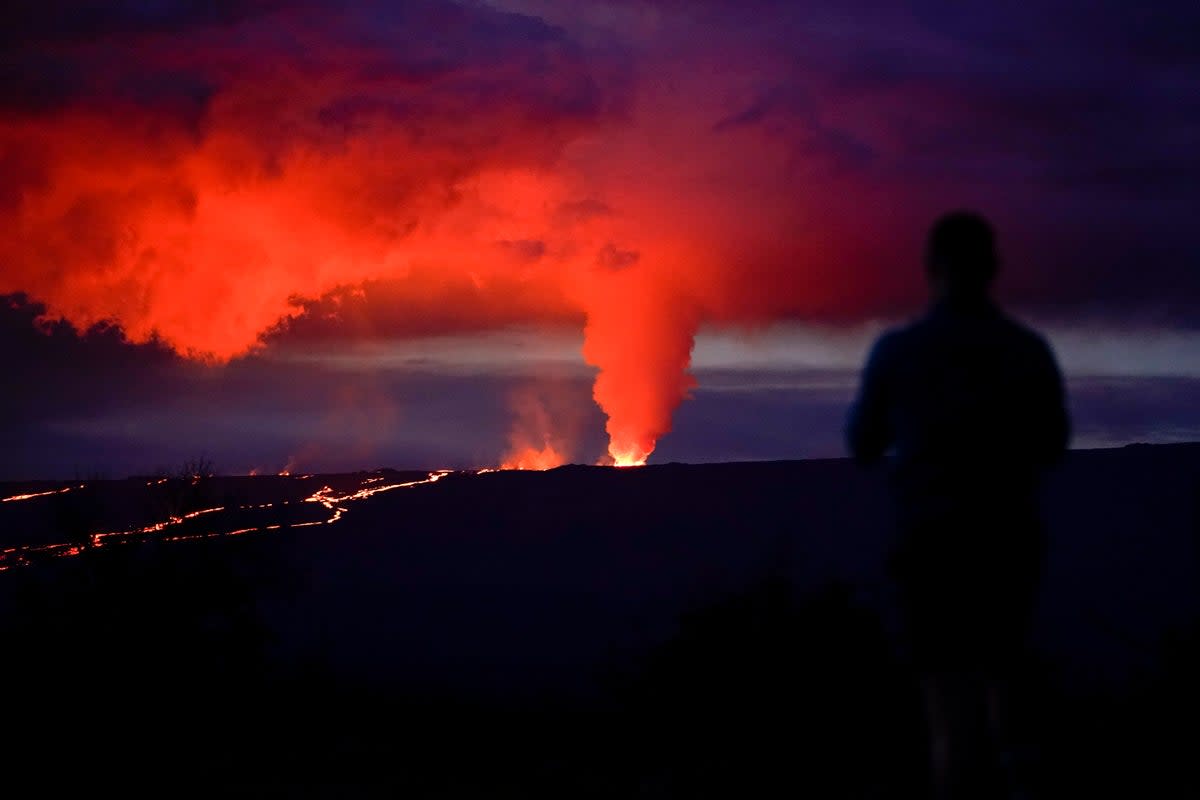Hawaii activates National Guard as lava from Mauna Loa eruption oozes toward highway

- Oops!Something went wrong.Please try again later.
Hawaiian officials have activated the state’s National Guard to assist in controlling traffic as lava from Mauna Loa continues to creep toward a central highway at risk of being shut down.
Officials on the island announced that 20 members of Hawaii National Guard had been called up to help with traffic control on Monday afternoon, more than a week after the volcano began spewing fountains of lava metres into the sky above for the first time in nearly four decades.
“Gov. David Ige and Maj. General Kenneth Hara activated 20 Hawai’i National Guard service members on Monday and placed them on active duty to assist Hawai’i County with traffic control and other roles in the Mauna Loa eruption,” Hawaii’s Emergency Management Agency said in a statement.
The group would likely remain activated for 30 days, but that could be extended depending on how long it takes for lava to reach the Daniel K Inouye Highway, as the slow-creeping flow threatens to shutter at least part of the shortest route linking two of the Big Island’s largest communities.
Hawaiian Volcano Observatory Scientist-in-Charge Ken Hon said Monday that the lava flow, which has slowed to a crawl in recent days, is now moving at about 20 feet per hour and is about 2.1 miles from the main road.
“With the lava being where it’s at, we feel pretty certain that the lava won’t impact any populated areas,” Hawaii County Mayor Mitch Roth said, continuing to emphasise that there remains no risk posed to the downslope communities at this time.
Hawaii's Defense Department said outgoing Gov. David Ige and Maj. General Kenneth Hara activated 20 Hawai'i National Guard service members on Monday and placed them on active duty to assist Hawai'i County with traffic control and other roles in the Mauna Loa eruption. #MaunaLoa
— Hawaii EMA (@Hawaii_EMA) December 5, 2022
“There’s a lot of (moving) pieces. How fast it’s moving. How close it’s gonna come to the highway. How long it will take if there’s any dangers that we’re seeing,” Mr Roth said during Monday’s news conference, according to Hawaii News Now. “And now we have another danger: We have to factor in if people are going out to that field that may close the highway sooner.
The USGS echoed that sentiment, describing Monday how since “there are many variables at play”, it makes it hard to predict exactly when and how residents will be impacted.
“Timing of flow advances are expected to change over periods of hours to days, making it difficult to estimate when or if the flow will impact Daniel K. Inouye Highway,” the geological survey said.
New insight about the erupting volcano was also provided to residents by Mr Hon, who noted that the activity at the site has stabilised in recent days, prompting the USGS to downgrade the alert system from red to orange for the first time in more than a week.
“There’s no slowing of material coming down the channel and feeding that front,” Mr Hon said, describing how the molten lava that continues to spew from the top of the volcano is now erupting at an estimated rate of 100 to 150 cubic yards per second, while the leading flow is about 15 ft thick and up to 30 ft at the centre.
“The front just moves very slowly because the material is very viscous and the ground is very flat.”
Mauna Loa, at nearly 14,000 feet above sea level, is the world’s largest active volcano. It last erupted in 1984, with the eruption lasting nearly three weeks but causing no major damage to the built environment.
Officials maintain that the risk posed to residents living in the downslope communities of Mauna Loa remains low, but the threat posed by the lava flow reaching the main thoroughfare that connects the two sides of the island has put those living in the communities of Hilo and Kona bracing for major upheaval.
While the immediate risk to communities remains low, health officials have urged children, the elderly, and people with respiratory conditions to cut down on their outdoor activities in the coming days as the air quality suffers due to the presence of volcanic ash and other substances like fine ash.

